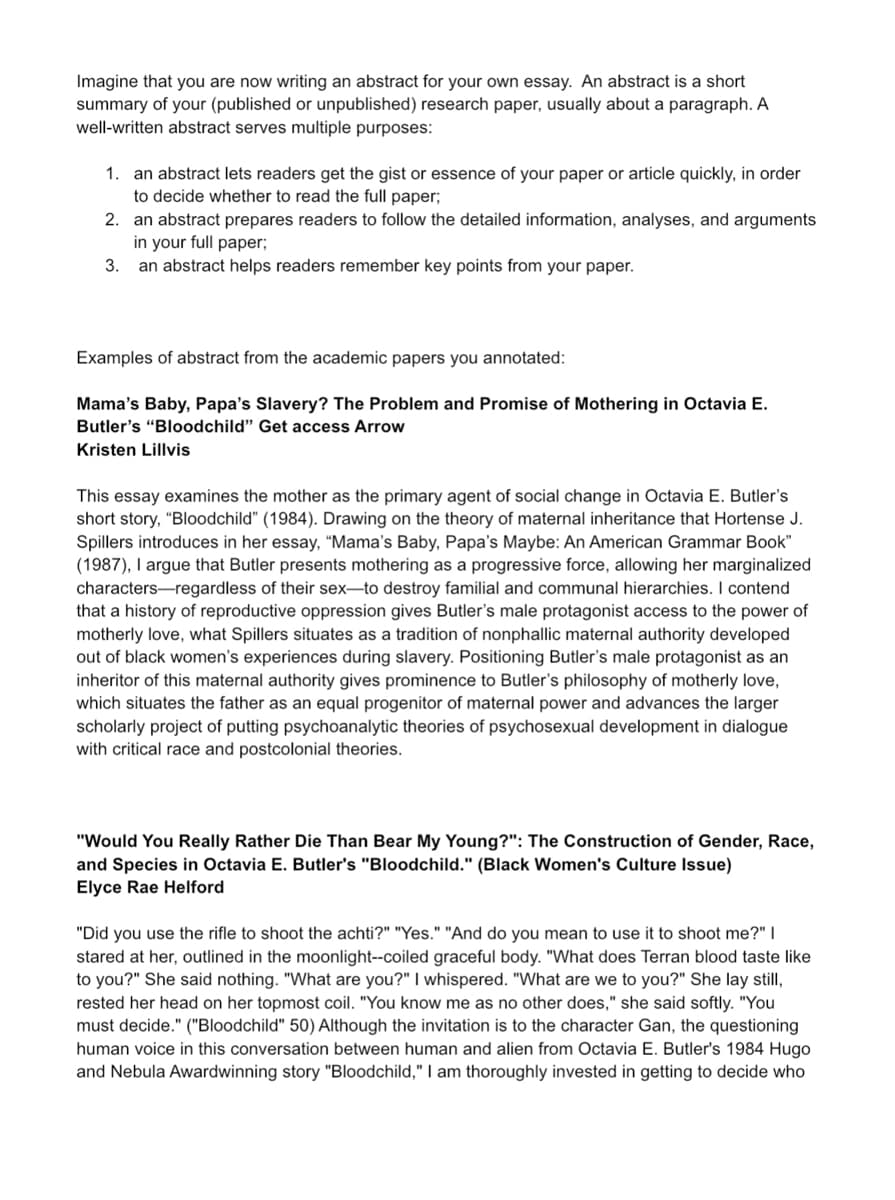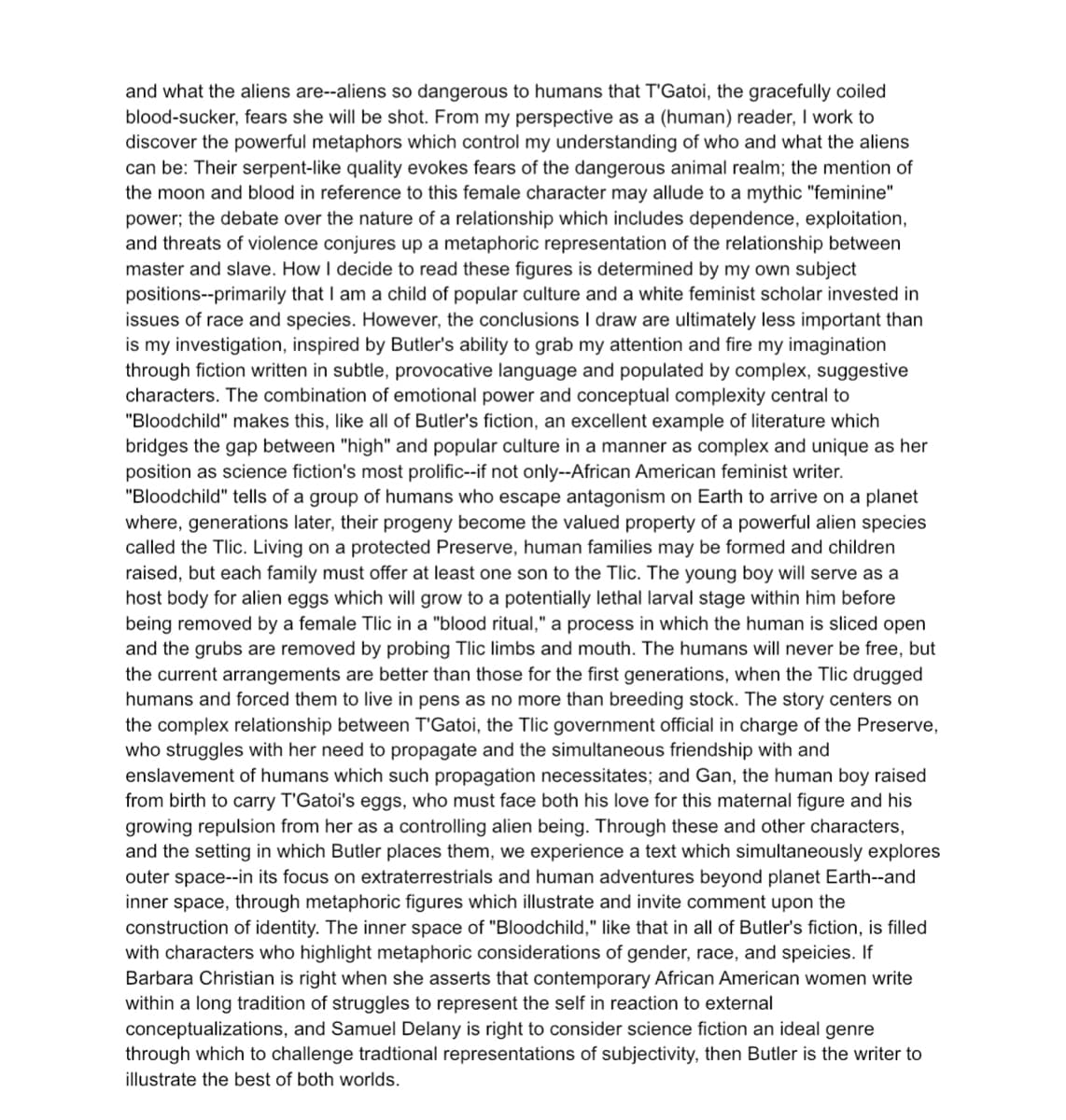write an abstract on this.
Social Psychology (10th Edition)
10th Edition
ISBN:9780134641287
Author:Elliot Aronson, Timothy D. Wilson, Robin M. Akert, Samuel R. Sommers
Publisher:Elliot Aronson, Timothy D. Wilson, Robin M. Akert, Samuel R. Sommers
Chapter1: Introducing Social Psychology
Section: Chapter Questions
Problem 1RQ1
Related questions
Question
write an abstract on this.
Thesis Statement: The essay explores Octavia E. Butler’s science fiction story “Bloodchild” as a narrative that constructs metaphors to delve into issues of gender, race, and species. The central thesis is that Butler employs metaphorical representations, such as the “pregnant man” and “Impregnating woman”, to challenge and deconstruct traditional societal norms and power structures. The essay examines the characters T’Gatoi and Gan to show how Butler uses metaphors to question and upset traditional gender roles, racial hierarchies, and species differences. It also talks about how popular culture can add to the postmodern state by filling in gaps and using tropes not covered in traditional philosophical and cultural discourse.
Supporting Points:
Metaphoric Exploration of Gender:
Butler’s “Bloodchild'' employs the metaphor of male pregnancy to challenge traditional gender roles. The essay argues that the depiction of men experiencing the pains of childbirth and the reversal of sexual imagery complicates the disruptions of conventional gender norms.
Intersectionality of Race and Gender:
The analysis extends beyond gender to encompass the intersectionality of race and species. Butler's narrative, as exemplified by the Oankali in her Xenogenesis Trilogy, illustrates the interconnectedness of these constructs. By examining the historical construction of race in Butler's other work, "Kindred," the essay contends that Butler's use of metaphors extends to ethnesis, highlighting the importance of race in the textual representation and deconstruction of identity.
Zoomorphesis and Species Construction:
The essay introduces the concept of zoomorphism, emphasizing how Butler's exploration of non-human animal species in "Bloodchild'' contributes to the deconstruction of humanist biases. Drawing parallels with Mary Midgley's work on the symbolic value of animals, the analysis contends that Butler challenges traditional representations of species by emphasizing the threatening nature of the "vast non-human realm" through metaphoric constructions.
Postmodern Feminist Engagement:
The essay positions Butler's work within the realm of postmodern feminist engagement. It asserts that Butler's science fiction, situated within the highly metaphoric genre, provides a meeting point between "high" and popular culture. Drawing on feminist theorist Alice Jardine's examination of gynesis, the essay contends that Butler's metaphors exemplify the promises inherent in dissolving boundaries between contemporary cultural categories.
Dissolving Boundaries in Popular Culture:
Butler's use of metaphors in "Bloodchild" is presented as a means to dissolve boundaries between theoretical and literary discourse. The essay suggests that Butler's narrative challenges traditional representations and tropes, contributing to the postmodern condition by addressing gaps in philosophy and cultural discourse. Through metaphoric considerations of identity, the story navigates gender, race, and species, illustrating the potential of popular culture to engage critically with societal constructs.

Transcribed Image Text:Imagine that you are now writing an abstract for your own essay. An abstract is a short
summary of your (published or unpublished) research paper, usually about a paragraph. A
well-written abstract serves multiple purposes:
1. an abstract lets readers get the gist or essence of your paper or article quickly, in order
to decide whether to read the full paper;
2. an abstract prepares readers to follow the detailed information, analyses, and arguments
in your full paper;
3. an abstract helps readers remember key points from your paper.
Examples of abstract from the academic papers you annotated:
Mama's Baby, Papa's Slavery? The Problem and Promise of Mothering in Octavia E.
Butler's "Bloodchild" Get access Arrow
Kristen Lillvis
This essay examines the mother as the primary agent of social change in Octavia E. Butler's
short story, "Bloodchild" (1984). Drawing on the theory of maternal inheritance that Hortense J.
Spillers introduces in her essay, “Mama's Baby, Papa's Maybe: An American Grammar Book"
(1987), I argue that Butler presents mothering as a progressive force, allowing her marginalized
characters regardless of their sex-to destroy familial and communal hierarchies. I contend
that a history of reproductive oppression gives Butler's male protagonist access to the power of
motherly love, what Spillers situates as a tradition of nonphallic maternal authority developed
out of black women's experiences during slavery. Positioning Butler's male protagonist as an
inheritor of this maternal authority gives prominence to Butler's philosophy of motherly love,
which situates the father as an equal progenitor of maternal power and advances the larger
scholarly project of putting psychoanalytic theories of psychosexual development in dialogue
with critical race and postcolonial theories.
"Would You Really Rather Die Than Bear My Young?": The Construction of Gender, Race,
and Species in Octavia E. Butler's "Bloodchild." (Black Women's Culture Issue)
Elyce Rae Helford
"Did you use the rifle to shoot the achti?" "Yes." "And do you mean to use it to shoot me?" I
stared at her, outlined in the moonlight--coiled graceful body. "What does Terran blood taste like
to you?" She said nothing. "What are you?" I whispered. "What are we to you?" She lay still,
rested her head on her topmost coil. "You know me as no other does," she said softly. "You
must decide." ("Bloodchild" 50) Although the invitation is to the character Gan, the questioning
human voice in this conversation between human and alien from Octavia E. Butler's 1984 Hugo
and Nebula Awardwinning story "Bloodchild," I am thoroughly invested in getting to decide who

Transcribed Image Text:and what the aliens are--aliens so dangerous to humans that T'Gatoi, the gracefully coiled
blood-sucker, fears she will be shot. From my perspective as a (human) reader, I work to
discover the powerful metaphors which control my understanding of who and what the aliens.
can be: Their serpent-like quality evokes fears of the dangerous animal realm; the mention of
the moon and blood in reference to this female character may allude to a mythic "feminine"
power; the debate over the nature of a relationship which includes dependence, exploitation,
and threats of violence conjures up a metaphoric representation of the relationship between
master and slave. How I decide to read these figures is determined by my own subject
positions--primarily that I am a child of popular culture and a white feminist scholar invested in
issues of race and species. However, the conclusions I draw are ultimately less important than
is my investigation, inspired by Butler's ability to grab my attention and fire my imagination
through fiction written in subtle, provocative language and populated by complex, suggestive
characters. The combination of emotional power and conceptual complexity central to
"Bloodchild" makes this, like all of Butler's fiction, an excellent example of literature which
bridges the gap between "high" and popular culture in a manner as complex and unique as her
position as science fiction's most prolific--if not only--African American feminist writer.
"Bloodchild" tells of a group of humans who escape antagonism on Earth to arrive on a planet
where, generations later, their progeny become the valued property of a powerful alien species
called the Tlic. Living on a protected Preserve, human families may be formed and children
raised, but each family must offer at least one son to the Tlic. The young boy will serve as a
host body for alien eggs which will grow to a potentially lethal larval stage within him before
being removed by a female Tlic in a "blood ritual," a process in which the human is sliced open
and the grubs are removed by probing Tlic limbs and mouth. The humans will never be free, but
the current arrangements are better than those for the first generations, when the Tlic drugged
humans and forced them to live in pens as no more than breeding stock. The story centers on
the complex relationship between T'Gatoi, the Tlic government official in charge of the Preserve,
who struggles with her need to propagate and the simultaneous friendship with and
enslavement of humans which such propagation necessitates; and Gan, the human boy raised
from birth to carry T'Gatoi's eggs, who must face both his love for this maternal figure and his
growing repulsion from her as a controlling alien being. Through these and other characters,
and the setting in which Butler places them, we experience a text which simultaneously explores
outer space--in its focus on extraterrestrials and human adventures beyond planet Earth--and
inner space, through metaphoric figures which illustrate and invite comment upon the
construction of identity. The inner space of "Bloodchild," like that in all of Butler's fiction, is filled
with characters who highlight metaphoric considerations of gender, race, and speicies. If
Barbara Christian is right when she asserts that contemporary African American women write
within a long tradition of struggles to represent the self in reaction to external
conceptualizations, and Samuel Delany is right to consider science fiction an ideal genre
through which to challenge tradtional representations of subjectivity, then Butler is the writer to
illustrate the best of both worlds.
Expert Solution
This question has been solved!
Explore an expertly crafted, step-by-step solution for a thorough understanding of key concepts.
This is a popular solution!
Trending now
This is a popular solution!
Step by step
Solved in 3 steps

Recommended textbooks for you

Social Psychology (10th Edition)
Sociology
ISBN:
9780134641287
Author:
Elliot Aronson, Timothy D. Wilson, Robin M. Akert, Samuel R. Sommers
Publisher:
Pearson College Div

Introduction to Sociology (Eleventh Edition)
Sociology
ISBN:
9780393639407
Author:
Deborah Carr, Anthony Giddens, Mitchell Duneier, Richard P. Appelbaum
Publisher:
W. W. Norton & Company

The Basics of Social Research (MindTap Course Lis…
Sociology
ISBN:
9781305503076
Author:
Earl R. Babbie
Publisher:
Cengage Learning

Social Psychology (10th Edition)
Sociology
ISBN:
9780134641287
Author:
Elliot Aronson, Timothy D. Wilson, Robin M. Akert, Samuel R. Sommers
Publisher:
Pearson College Div

Introduction to Sociology (Eleventh Edition)
Sociology
ISBN:
9780393639407
Author:
Deborah Carr, Anthony Giddens, Mitchell Duneier, Richard P. Appelbaum
Publisher:
W. W. Norton & Company

The Basics of Social Research (MindTap Course Lis…
Sociology
ISBN:
9781305503076
Author:
Earl R. Babbie
Publisher:
Cengage Learning

Criminalistics: An Introduction to Forensic Scien…
Sociology
ISBN:
9780134477596
Author:
Saferstein, Richard
Publisher:
PEARSON

Sociology: A Down-to-Earth Approach (13th Edition)
Sociology
ISBN:
9780134205571
Author:
James M. Henslin
Publisher:
PEARSON

Society: The Basics (14th Edition)
Sociology
ISBN:
9780134206325
Author:
John J. Macionis
Publisher:
PEARSON